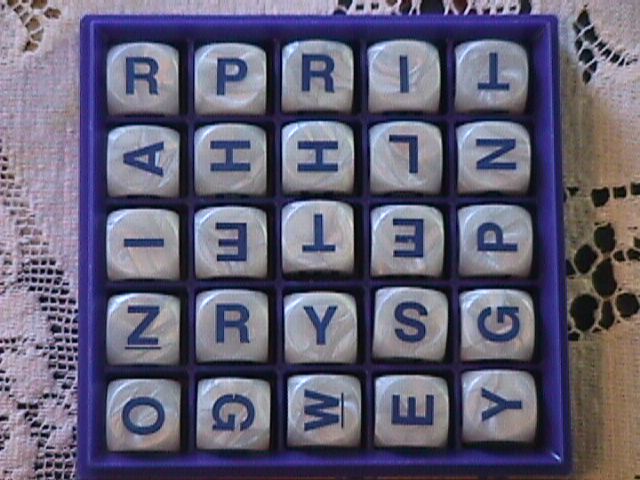 Boggle: 16 or 25 letter cubes get mixed around and then fall into place in either a 4x4 or 5x5 grid (the 25-cube version is the best). The object of the game is to make as many words as possible by connecting adjacent strings of letters. In competitive play, this is done with a timer, but the game can be played solo and in a relaxed manner, simply by looking at the grid of letters and finding words. You can also do this just by typing or writing out a random grid of letters, or using letter tiles from other other words games (see below).
Boggle: 16 or 25 letter cubes get mixed around and then fall into place in either a 4x4 or 5x5 grid (the 25-cube version is the best). The object of the game is to make as many words as possible by connecting adjacent strings of letters. In competitive play, this is done with a timer, but the game can be played solo and in a relaxed manner, simply by looking at the grid of letters and finding words. You can also do this just by typing or writing out a random grid of letters, or using letter tiles from other other words games (see below). Bananagrams or Speed Scrabble: Bananagrams is fun and simple game sold as 144 tiles in a banana-shaped pouch. Players draw 21 tiles and make crossword configurations and try to use all of their tiles. If stuck, a player can say "Dump" and exchange 1 tile for 3 others in the pool. A player using all their tiles calls "Peel" and each player must draw 1 tile and continue playing until all the tiles are used. The game can also be played using the 100 tiles from a Scrabble set, 200 tiles from Super Scrabble, or just by writing letters on little slips of paper.
Bananagrams or Speed Scrabble: Bananagrams is fun and simple game sold as 144 tiles in a banana-shaped pouch. Players draw 21 tiles and make crossword configurations and try to use all of their tiles. If stuck, a player can say "Dump" and exchange 1 tile for 3 others in the pool. A player using all their tiles calls "Peel" and each player must draw 1 tile and continue playing until all the tiles are used. The game can also be played using the 100 tiles from a Scrabble set, 200 tiles from Super Scrabble, or just by writing letters on little slips of paper.Secret Letters: You can "up-level" the above games by playing this variation where words are formed from a jumble of letter tiles, but the tiles remain jumbled in the center of the table. Here's how:
Step 2: Each player receives a face down tile, called "Secret Letters," which only they may look at.
Step 3: Without touching the tiles in the middle of the table, players take turns forming words of 4 or more letters, keeping track of which letters have been used. Words cannot be formed from tiles that have already been used.
Step 4: A player may turn over a Secret Letter to use it as part of a word—or to join with the letters of an already existing word, thereby forming a new word.
Step 5: When no more words can be made, the round is over. Each player scores 1 point for word created.
Step 6: Deal out the next round, increasing the number of tiles in the pool by 1, and the number of Secret Letters in each player's hand by 1.
What's Going On: The ability to conceptualize things that make sense out of jumbles of nonsense increases our ability to see and think clearly.
Testimonial: I've always been drawn to these kinds of games and find that one gets better at them with practice. They helped me stabilize my vision, boost my vocabulary, and have fun with friends and family.
More Info:
• Secret Letters came from Marc Grossman's book, Greater Vision, where he explains more about how these games improve the vision.
• David Parlett has some awesome books about word games, most of which don't require any equipment to play. He's also posted some online here.


Hey there. You can play Speed Scrabble Online. Fun!
ReplyDelete